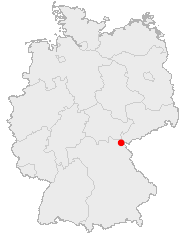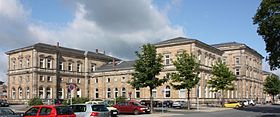Hofer Land

The Hofer Land (also the Hof region and the Bavarian Vogtland ) is located in Upper Franconia in the northeast of the Free State of Bavaria . The Hofer Land includes the independent city of Hof and the district of Hof , but also northern parts of the district of Wunsiedel in the Fichtelgebirge around the cities of Selb , Kirchenlamitz and Weißenstadt . Over 170,000 people live in the region.
history
Historically, the Hofer Land goes back to the Landeshauptmannschaft Hof of the Margraviate of Brandenburg-Kulmbach . The margrave had the Hof land book drawn up to document his property .
The alternative name Bayerisches Vogtland , which is used today, refers to the even older past, to the time of clearing and the first settlement by Franconian immigrants. The region was under the administration of the Weida bailiffs from the 12th to 14th centuries . Today the Hofer Heimatmuseum bears the name Museum Bayerisches Vogtland and the junction of the A 72 and the A 9 is also called the Bavarian Vogtland triangle .
The region has structural problems and is one of the economically weaker areas in Bavaria. For a long time, the Hofer Land had the highest unemployment rates in Bavaria. The problem was mainly due to the proximity to the Eastern Bloc (GDR / Czechoslovakia). However, this has improved significantly in recent years. In December 2018, the unemployment rate in the city of Hof was 5.3% and in the district of Hof it was 2.7%.
Today the Hofer Land is economically very important. There are numerous large companies in the region. The city of Hof and the surrounding area in particular have large and modern companies such as Nexans Power Accessories Germany GmbH, Accenture Services GmbH and Dennree GmbH. There are other large companies in Rehau ( Rehau AG and Lamilux GmbH) in Schwarzenbach an der Saale (Sandler AG) and in Oberkotzau ( GEALAN Fenster-Systeme GmbH and Gealan Formteile GmbH)
In the course of the consolidation process in 2004, the Archdiocese of Bamberg initiated a structural reform. In this context, the Catholic parishes of the city and the district of Hof merged in June 2019 to form the pastoral care area Hofer Land . The dean's offices in Hof and Kulmbach subsequently merged to form the dean's office in Hof. From September 2019, the until this date independent adult education centers in the city of Hof and the district of Hof will merge to form the adult education center Hofer Land , based in Hofer Ludwigstrasse.
Geography and climate
The northeastern part of the Hofer Land is also known as the Regnitzland . The area lies on both sides of the border between the Central Vogtland hill country (part of the Vogtland , located in the northeast) and the Münchberg plateau (part of the Thuringian-Franconian low mountain range , located in the southwest).
In the Hofer Land, similar to the Saxon Vogtland , where it is usually even colder - compared to the neighboring Bavarian areas - the climate is rather harsh . Short, warm summers and longer, cold winters are characteristic. Presumably due to climate change , however, the growing season in the Hofer Land has noticeably increased.
traffic
The Hof region is conveniently located thanks to the following infrastructure:
- the Hof-Plauen airfield ,
- the Hof Main Station ,
- the highways A 9 , A 72 and A 93 ,
- the federal highways B 2 , B 15 and B 173 .
The most important traffic structures are in Hof, and there are also the Münchberg , Helmbrechts , Rehau , Naila and Bad Steben train stations and the Ottengrüner Heide airfield.
Attractions
Marienkirche in the old town of Hof
Michaeliskirche and town hall in the classical Hofer Neustadt
International music meeting place Haus Marteau in Lichtenberg
Kurhaus Bad Steben
Hell valley near Selbitz
Naila in the Franconian Forest
Rehau , model city of Bavaria
Erika Fuchs House in Schwarzenbach
Saalequelle near Zell in the Fichtelgebirge
people
As a cultural region, the Hofer Land was and is the birthplace or place of work of numerous artists, composers, musicians, actors, writers and scientists. The reformers Nikolaus Decius , Caspar Löner and Nikolaus Medler came from or worked in the Hofer Land and were in contact with Martin Luther . The provost of St. Hedwig's Cathedral in Berlin , Bernhard Lichtenberg , died in Hof in 1943. During the National Socialist dictatorship he stood up for the persecuted and is honored as Righteous Among the Nations in Yad Vashem .
The German writer Jean Paul lived in Joditz , Schwarzenbach an der Saale and Wunsiedel , attended the grammar school later named after him in Hof and lived from 1784 to 1787 in his mother's house in Hof. The French violinist Henri Marteau lived in his villa in Lichtenberg until his death . The Henri Marteau International Violin Competition is being held in his honor . The basics for the periodic table of the chemical elements were thought out by Johann Wolfgang Döbereiner . The automobile designer and founder of the Audi brand August Horch lived in Münchberg from 1945 until his death.
The lawyer Johann Georg August Wirth was a political writer of the Vormärz , fighter for freedom of the press and a member of the Frankfurt National Assembly . A number of well-known politicians were born in Hofer Land. The best known include u. a. Georg Freiherr von Waldenfels and Hans-Peter Friedrich .
The tradition of organ building has existed in Hofer Land since the 18th century with the Silbermann student Johann Nikolaus Ritter , his partner Johann Jakob Graichen, his student Friedrich Heidenreich and his son Eberhard . The organ builder and organist Karsten Hörl continues this tradition .
See also: List of Hofer personalities
Web links
![]() Wikipedia: WikiProjekt Hofer Land - Wikipedia-internal specialist editorial office on the subject of Hofer Land
Wikipedia: WikiProjekt Hofer Land - Wikipedia-internal specialist editorial office on the subject of Hofer Land
- Link catalog on the subject of farm (district) at curlie.org (formerly DMOZ )
- Link catalog on the subject of courtyard (city) at curlie.org (formerly DMOZ )

























